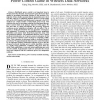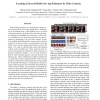388 search results - page 51 / 78 » The covering number in learning theory |
BMCBI
2010
13 years 7 months ago
2010
Background: Biological networks offer us a new way to investigate the interactions among different components and address the biological system as a whole. In this paper, a revers...
JAIR
2008
13 years 7 months ago
2008
It is well-known that acting in an individually rational manner, according to the principles of classical game theory, may lead to sub-optimal solutions in a class of problems nam...
TON
2008
13 years 7 months ago
2008
Distributed power control is an important issue in wireless networks. Recently, noncooperative game theory has been applied to investigate interesting solutions to this problem. Th...
ICCV
2011
IEEE
12 years 7 months ago
2011
IEEE
Most existing techniques for analyzing face images assume that the faces are at near-frontal poses. Generalizing to non-frontal faces is often difficult, due to a dearth of groun...
IMC
2007
ACM
13 years 9 months ago
2007
ACM
The ability to discover network organization, whether in the form of explicit topology reconstruction or as embeddings that approximate topological distance, is a valuable tool. T...


